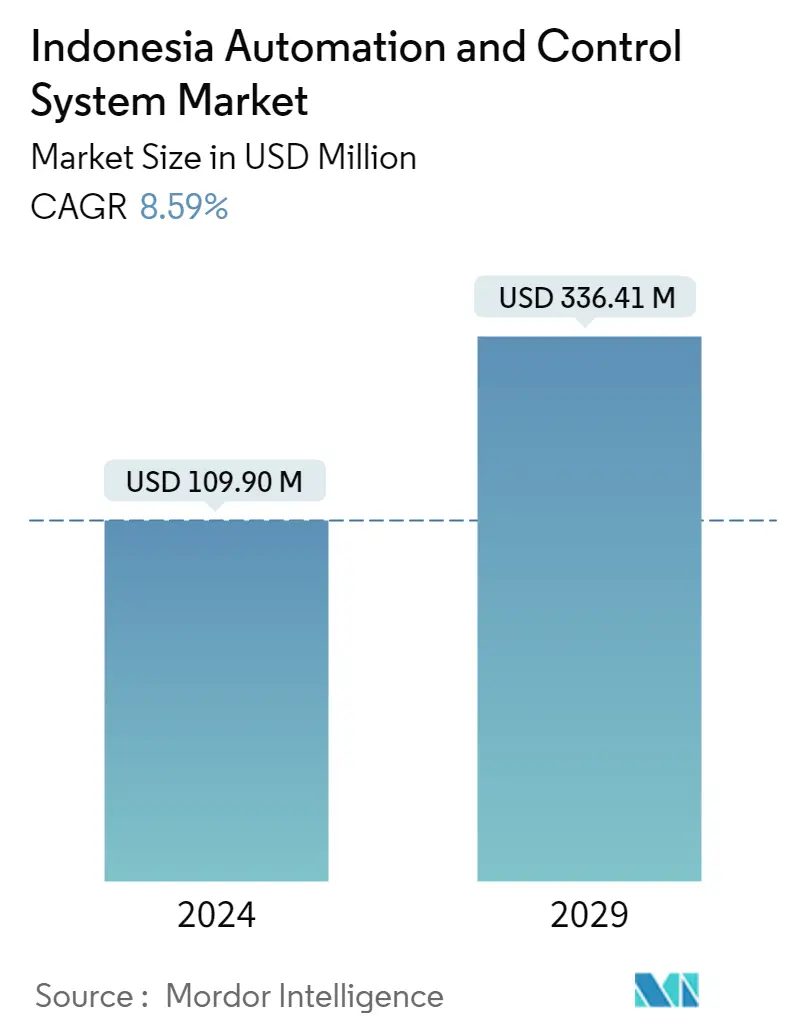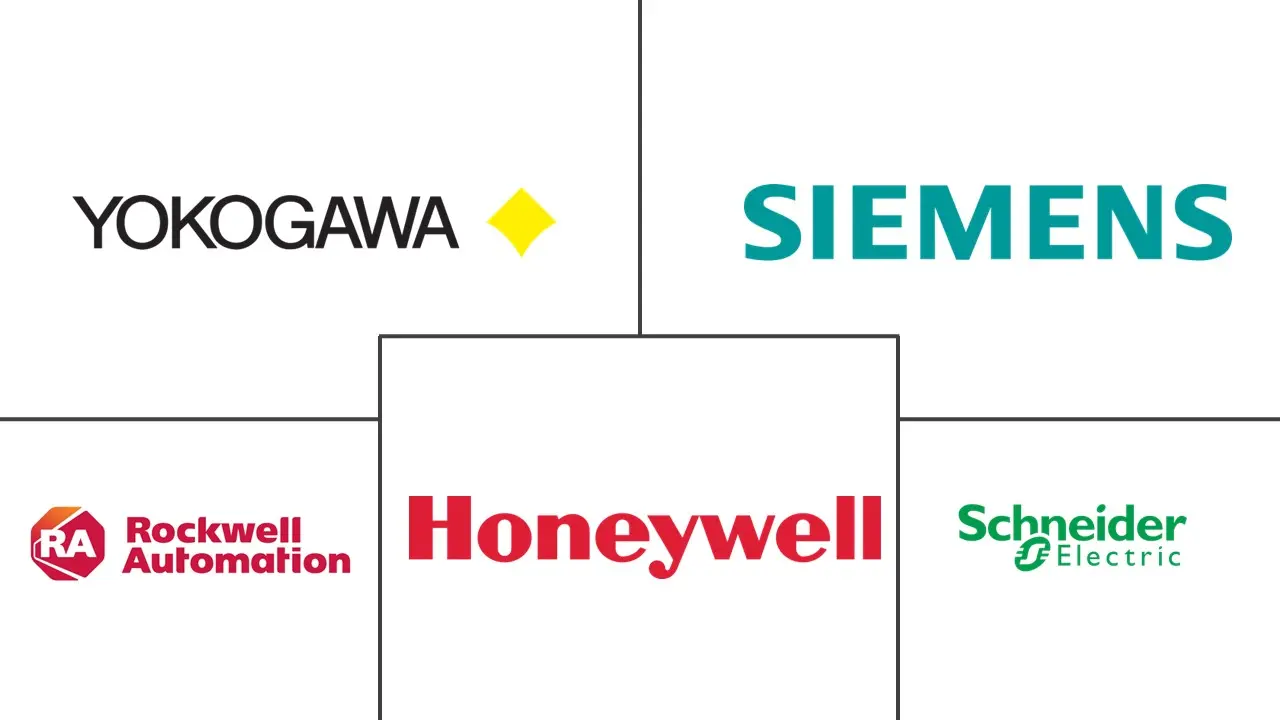Market Size of Indonesia Automation And Control System Industry

| Study Period | 2019 - 2029 |
| Base Year For Estimation | 2023 |
| Market Size (2024) | USD 109.90 Million |
| Market Size (2029) | USD 336.41 Million |
| CAGR (2024 - 2029) | 8.59 % |
| Market Concentration | Medium |
Major Players
*Disclaimer: Major Players sorted in no particular order |
Indonesia Automation and Control System Market Overview
The Indonesia Automation and Control System Market size is estimated at USD 109.90 million in 2024, and is expected to reach USD 336.41 million by 2029, growing at a CAGR of 8.59% during the forecast period (2024-2029).
With Indonesia's steady amalgamation with the world's economy, Indonesia's Automation and Control System will be essential in bringing costs down.
- Automation and Control System refers to systems that oversee and control a wide range of processes involved in manufacturing and distributing goods and services. Many universal and essential services depend on Automation and Control Systems, from assembly lines to power stations. For example, many utility or telecommunication infrastructures that maintain a modern nation's social, industrial, and economic well-being rely on Automation and Control Systems.
- Indonesia is a prominent industrial manufacturer that highly adopts automation in its industries. Manufacturing contributes a considerable amount to a country's GDP. For instance, according to Statistics Indonesia, in 2022, Indonesia's manufacturing sector contributed over 18 percent of the country's GDP, the most significant contributor to the nation's economy. The robust manufacturing activities in Indonesia and Malaysia will likely augment the demand for the studied market.
- Growing government funding to encourage automated systems in numerous industrial verticals, booming demand for automation from different manufacturing sectors, increasing innovations in industrial robotics, swelling technological advancements in manufacturing, and the need for mass production and related supply chains to cater to the rising population are the crucial factors driving the growth of automation and process control systems market in Indonesia.
- Indonesia's mineral resources are vast and unexplored, and it is the world's largest exporter of Tin, palm oil, and thermal coal. It is also one of the major exporters of Nickel, Copper, Bauxite, Rubber, Manganese, Zinc, and Lead, among others. Mining accounts for about a tenth of Indonesia's GDP and has played a vital role in the country's economic development over the years. The rising demand for metals and minerals, with the growing demand for semiconductors and electronics, fuels the adoption of automated systems in the mining sector.
- The energy sector is experiencing an increase in demand for automation and control systems due to the emergence of smart city programs. Indonesia has taken the lead in this regard by launching the 100 Smart Cities Movement, a comprehensive digitalization program aimed at addressing urbanization challenges. This initiative is part of the government's plan to tackle the issue of urbanization, with projections indicating that 83 percent of the Indonesian population will reside in urban areas by 2045.
- Indonesia is also encouraging the use of biomass to improve the greening of existing Steam Power Plants through the innovative Biomass Co-Firing program. The program aims to co-fire biomass in 52 locations by 2025 and has already co-fired biomass in 37 areas, using 306 thousand tons to reach the 1.08 million ton target by 2023. Such programs and new projects and investments to develop the power and utility sector of the country are expected to create new market opportunities for the implementation of automation and control systems in the country.
- However, the initial costs associated with automation and control systems are high. The complexity of customization and integration adds to the overall costs. Moreover, installing automation equipment may require modifications to the existing infrastructure of the factory. This can include changes to the layout, electrical systems, and safety features to accommodate new equipment, which incur additional costs. Such factors might hinder the market growth.
Indonesia Automation and Control System Industry Segmentation
Industrial automation is applying different and combined control systems to manage and operate machines and equipment in production facilities and factories. In addition to reducing costs, automation is being demanded to help increase productivity, aesthetics, efficiency, and delivery systems in the production of automotive assemblies, aircraft, steering and ship stabilization, heat-treating boilers and ovens, and other machinery.
Indonesia's automation and control system market is segmented by product (programmable logic controller, supervisory control and data acquisition, distributed control system, human-machine interface, safety systems, industrial robotics, electric motors, drives) and end-user industry (oil & gas, power, chemical & petrochemical, food & beverage, metals & mining, water, and wastewater).
The market sizes and forecasts are provided in terms of value in USD for all the above segments.
| Product | |
| Programmable Logic Controller | |
| Supervisory Control and Data Acquisition | |
| Distributed Control System | |
| Human Machine Interface | |
| Safety Systems | |
| Industrial Robotics | |
| Electric Motors (includes AC, DC, EC, Servo and Stepper Motors) | |
| Drives (includes AC,DC and Servo) |
| End-User Industry | |
| Oil & Gas | |
| Power | |
| Chemical & Petrochemical | |
| Food & Beverage | |
| Metals & Mining | |
| Water and Wastewater | |
| Other End-User Industries |
Indonesia Automation And Control System Market Size Summary
The Indonesian automation and control system market is poised for significant growth, driven by the country's integration into the global economy and its robust industrial manufacturing sector. Automation and control systems are crucial for managing processes in various industries, including manufacturing, energy, and mining, which are vital to Indonesia's economic landscape. The government's initiatives, such as the 100 Smart Cities Movement and the Biomass Co-Firing program, are fostering the adoption of these systems to address urbanization and environmental challenges. Additionally, the food and beverage sector, a major contributor to the national GDP, is increasingly embracing digital transformation and automation to enhance production efficiency and food safety. This trend is supported by the Making Indonesia 4.0 strategy, which encourages the adoption of advanced technologies like IoT, robotics, and AI.
The market is characterized by moderate competition, with several major players dominating the landscape. Companies like Yokogawa Corporation, Siemens AG, Honeywell International Inc., and Rockwell Automation Inc. are actively expanding their presence and enhancing their product offerings to meet the growing demand for automation solutions. Innovations such as the integration of EcoStruxure Power Operation with ETAP systems and the launch of new automation controllers by OMRON highlight the industry's focus on improving operational efficiency and sustainability. Despite the high initial costs and complexity associated with implementing automation systems, the potential for cost reduction and increased productivity continues to drive market growth in Indonesia.
Indonesia Automation And Control System Market Size - Table of Contents
-
1. MARKET INSIGHTS
-
1.1 Market Overview
-
1.2 Industry Attractiveness - Porter's Five Forces Analysis
-
1.2.1 Bargaining Power of Suppliers
-
1.2.2 Bargaining Power of Buyers
-
1.2.3 Threat of New Entrants
-
1.2.4 Threat of Substitute Products
-
1.2.5 Intensity of Competitive Rivalry
-
-
1.3 Assessment of the impact of COVID-19 on the industry
-
-
2. MARKET SEGMENTATION
-
2.1 Product
-
2.1.1 Programmable Logic Controller
-
2.1.2 Supervisory Control and Data Acquisition
-
2.1.3 Distributed Control System
-
2.1.4 Human Machine Interface
-
2.1.5 Safety Systems
-
2.1.6 Industrial Robotics
-
2.1.7 Electric Motors (includes AC, DC, EC, Servo and Stepper Motors)
-
2.1.8 Drives (includes AC,DC and Servo)
-
-
2.2 End-User Industry
-
2.2.1 Oil & Gas
-
2.2.2 Power
-
2.2.3 Chemical & Petrochemical
-
2.2.4 Food & Beverage
-
2.2.5 Metals & Mining
-
2.2.6 Water and Wastewater
-
2.2.7 Other End-User Industries
-
-
Indonesia Automation And Control System Market Size FAQs
How big is the Indonesia Automation and Control System Market?
The Indonesia Automation and Control System Market size is expected to reach USD 109.90 million in 2024 and grow at a CAGR of 8.59% to reach USD 336.41 million by 2029.
What is the current Indonesia Automation and Control System Market size?
In 2024, the Indonesia Automation and Control System Market size is expected to reach USD 109.90 million.

